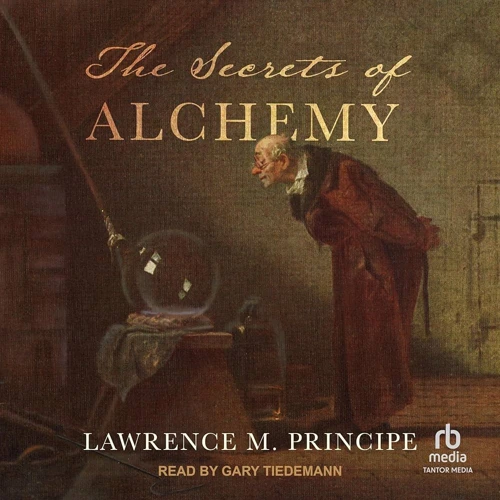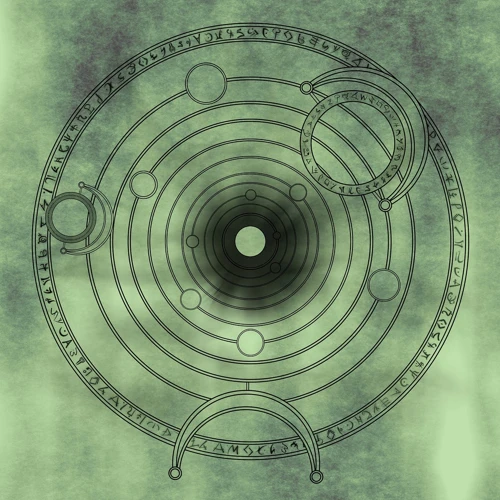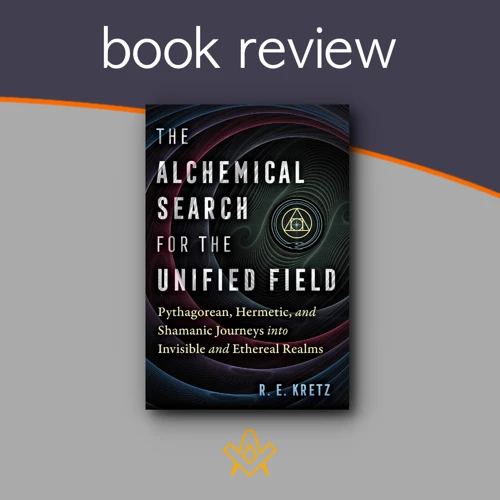In the ancient world, a mysterious and captivating connection existed between mysticism and alchemy. The intertwining of these two fields of study provided a profound and enigmatic understanding of the universe, the human spirit, and the search for enlightenment. Ancient mystical beliefs and practices laid the foundation for the birth of alchemy, which in turn incorporated mystical principles into its philosophies. Within the alchemical process, symbolism and hidden meanings were utilized to guide seekers on a transformative path towards spiritual enlightenment. The quest for immortality became a central focus in both mysticism and alchemy, as practitioners sought to unlock the secrets of eternal life. The profound connection between mysticism and alchemy leaves a lasting legacy, impacting the spiritual and intellectual pursuits of humanity throughout history.
Mysticism in the Ancient World

Mysticism in the ancient world encompassed a vast array of beliefs and practices, intertwining with various cultural and spiritual traditions. Ancient mystics delved into the realms of spirituality, seeking a deeper understanding of the universe and their place within it. From the mystical beliefs surrounding the divine and transcendence to the practices and rituals that facilitated spiritual experiences, mysticism was a pervasive force in the ancient world. These mystical beliefs not only influenced the spiritual realm but also had a profound impact on other aspects of life, including healing and medicine. Ancient mystics explored the connection between the spiritual and physical realms, employing rituals and ceremonies to bring about healing and well-being. The rich tapestry of mystical traditions in the ancient world continues to captivate and inspire us today, offering a glimpse into the hidden dimensions of existence.
1.1 Ancient Mystical Beliefs
Ancient mystical beliefs encompassed a diverse range of spiritual concepts and philosophies, deeply rooted in the cultures and societies of the time. These beliefs varied across different civilizations, yet shared common threads that connected humanity’s quest for understanding and transcendence. One prevalent belief was the existence of a divine force or higher power, often worshiped in the form of gods and goddesses. These deities were believed to possess immense power and influence over various aspects of life, from fertility and harvest to war and wisdom. Ancient mystics sought to establish a profound connection with these divine beings through rituals, ceremonies, and offerings. The belief in the afterlife and the existence of souls was another significant aspect of ancient mystical belief systems. It was believed that the soul transcended bodily death, continuing its journey in realms beyond the physical world. This belief in the continuation of the soul’s existence led to practices that aimed at ensuring a positive and auspicious afterlife, such as burial rituals, religious ceremonies, and offerings to appease the spirits of ancestors. Additionally, the concept of cosmic order and balance played a crucial role in ancient mystical beliefs. The belief in the interconnectedness of all things and the influence of celestial bodies on earthly affairs guided the understanding of fate, destiny, and the cycles of life. Ancient mystics studied celestial movements, such as the positions of stars and planets, in order to gain insights into the workings of the universe and to align their actions with cosmic rhythms. The exploration of these ancient mystical beliefs provides a window into the rich tapestry of spiritual traditions and practices that shaped the ancient world. It also sheds light on the profound influence these beliefs had on diverse aspects of life, including healing medicine and the development of mystical practices, rituals, and ceremonies. (Link: mystical practices and ancient rituals)
1.2 Practices and Rituals
Practices and rituals played a significant role in ancient mystical traditions, serving as pathways to connect with the divine and unlock hidden knowledge. These practices varied across different cultures and spiritual systems, but they all shared a common goal of transcending the mundane and reaching a higher spiritual state. Meditative practices, such as deep contemplation and visualization, were utilized to quiet the mind and open oneself to spiritual insights. Certain rituals involved the use of sacred objects, symbols, and incantations to invoke higher powers and access mystical realms. Dancing, chanting, and ecstatic experiences were also employed as means of entering altered states of consciousness. These rituals often took place in sacred spaces, such as temples or natural landscapes believed to be imbued with spiritual energy. They were performed with utmost reverence and accompanied by strict protocols to ensure their efficacy. The interplay between practices and rituals in ancient mysticism was an integral part of the spiritual journey, helping individuals transcend their physical limitations and explore the depths of their being. These mystical practices and rituals also had a profound influence on other aspects of ancient life, including healing and medicine, where they were recognized as powerful tools for achieving physical and emotional well-being. (Anchor: /the-influence-of-mystical-beliefs-on-ancient-healing-medicine/)
The Origins of Alchemy

The origins of alchemy can be traced back to ancient civilizations, where it emerged as a philosophical and mystical pursuit. Alchemy sought to uncover the secrets of nature, the universe, and the human spirit through a combination of scientific observation and spiritual exploration. Rooted in the mystical traditions of the past, alchemy drew inspiration from the transformative practices of ancient mystics who sought to unlock the hidden knowledge of the universe. Within the alchemical philosophies, the idea of transmutation played a central role, as practitioners aimed to transform base elements into pure and divine substances. The ancient magickal tradition that encompassed alchemy offered a unique perspective on the interplay between physical matter and spiritual essence, paving the way for the intricate and enigmatic journey of alchemical exploration. Through the unveiling of this magickal tradition, ancient mystics laid the groundwork for the development and evolution of alchemy.
2.1 Alchemical Principles and Philosophies
Alchemical principles and philosophies formed the foundation of the mystical art of alchemy, shaping its theories and practices. At the heart of alchemy was the belief in the transformation of base substances into higher states, both physically and spiritually. This transformative process was guided by several key principles. One principle was the concept of “correspondences,” which linked various elements and substances in the universe. This interconnectedness allowed alchemists to manipulate and transmute matter. Another principle was the belief in the unity of opposites, where opposing forces such as hot and cold, wet and dry, were seen as complementary rather than conflicting. This understanding allowed alchemists to find balance and harmony within their experiments. The process of transmutation was often likened to the spiritual journey of the alchemist, where the purification of metals mirrored the purification of the soul. Alchemical philosophies also incorporated mystical beliefs such as the pursuit of the Philosopher’s Stone, a legendary substance said to possess the power to transmute base metals into gold and grant immortality. The mysterious nature of alchemy and its intertwined relationship with mysticism continue to intrigue seekers of esoteric wisdom.
To learn more about the ancient mystical traditions that influenced alchemy, check out our article on the unveiling of the magickal tradition of ancient mystics.
2.2 Influences from Mysticism
The field of alchemy was deeply influenced by mysticism, with mystical beliefs and practices playing a significant role in shaping its principles and philosophies. Mysticism introduced a spiritual dimension to the study of alchemy, emphasizing the connection between the material and the divine. One of the key influences from mysticism on alchemy was the concept of divine unity, which posited that all things were interconnected and reflective of a larger cosmic order. This idea aligned with the alchemical principle of the unity of opposites, which emphasized the harmony and balance between opposing forces. Mystical beliefs in the existence of higher realms and spiritual beings also found their way into alchemical thought. Alchemists believed that the transformation of base metals into gold mirrored the spiritual transformation of the human soul, symbolizing the attainment of spiritual enlightenment and transcendence. The mystical concept of the microcosm and macrocosm, the idea that the universe and the individual were reflections of each other, also influenced alchemical philosophies. Alchemists saw their laboratory work as a means of creating a microcosm that mirrored the workings of the macrocosm. Mystical practices such as meditation and visualization techniques were incorporated into the alchemical process, enabling practitioners to access spiritual realms and harness higher energies for their work. The influence of mysticism on alchemy enriched the field with spiritual depth and transcendent aspirations.
The Alchemical Process

The alchemical process is a mystical and transformative journey that seeks to unravel the secrets of nature and the self. Central to alchemy is the extensive use of symbolism and hidden meanings, often represented through intricate diagrams and cryptic language. These symbols and codes served as a guide for alchemists to navigate the complexities of their spiritual and material experiments. Within this alchemical process, practitioners aimed to achieve spiritual transformation, believing that by purifying their inner selves, they could also transmute base metals into noble substances. This process mirrored the concept of self-realization and the search for higher consciousness. The alchemical process, with its enigmatic rituals and esoteric teachings, ultimately aimed to unlock the inherent spiritual potential within individuals, leading them on a path of enlightenment and self-discovery.
3.1 Symbolism and Hidden Meanings
Symbolism played a crucial role in the practice of alchemy, particularly in relation to hidden meanings. Alchemists believed that the physical processes they engaged in were reflections of spiritual transformations and the quest for enlightenment. They used symbols as a language to convey complex ideas and concepts that could not be easily expressed through words alone. These symbols were often rich in visual imagery, drawing upon elements from nature, mythology, astrology, and religious iconography. The alchemical symbols were intended to represent not only the physical substances and elements used in their experiments but also the various stages of the alchemical process. For example, the symbol of the ouroboros, a serpent biting its own tail, represented the cyclical nature of life and death, as well as the continuous process of transformation and rebirth. Another potent symbol in alchemy was the philosopher’s stone, which represented the ultimate goal of the alchemist – the transformation of base metals into gold and the attainment of spiritual enlightenment. The true meaning of these symbols was often veiled and known only to initiates of the alchemical arts, adding an air of mystery and secrecy to the practice. By deciphering and understanding the hidden meanings behind these symbols, alchemists believed they could unravel the profound truths of the universe and their own spiritual journey. The use of symbolism in alchemy continues to captivate the imagination, evoking a sense of wonder and mysticism in those who delve into its enigmatic world.
3.2 Spiritual Transformation
Spiritual Transformation
Spiritual transformation was at the core of the alchemical process, intertwining with the mystical aspects of ancient beliefs. Alchemy sought to bring about a profound change within individuals, not only on a physical level but also on a spiritual and metaphysical level. Through the symbolic language of alchemy, practitioners aimed to transmute not only base metals into gold but also to transmute their own consciousness into a higher spiritual state. The process of spiritual transformation involved a deep exploration of the self, purging the impurities of the ego and cultivating spiritual virtues. This inner work was often represented through alchemical symbols such as the union of opposites, the death and rebirth of the alchemical process, and the attainment of the philosopher’s stone. The alchemist sought to refine their own being, aligning themselves with the divine and accessing higher realms of consciousness. Ultimately, spiritual transformation in alchemy aimed to achieve enlightenment and union with the divine, unlocking the hidden potential within the human spirit. This quest for spiritual transformation continues to resonate with seekers of wisdom and truth, offering a path to inner illumination and self-realization.
Alchemy and the Quest for Immortality

Alchemy, a fascinating practice that emerged in the ancient world, was deeply intertwined with the quest for immortality. Alchemists believed that through their knowledge and experimentation, they could discover the secret to eternal life. Central to this quest was the creation of elixirs of life, concoctions believed to grant immortality. Alchemical texts and teachings were filled with intricate instructions on how to create these elixirs using various substances and processes. The pursuit of immortality also involved alchemical practices aimed at transforming the practitioner spiritually, enabling them to transcend the limitations of the mortal realm. While the physical immortality sought by alchemists may have remained elusive, the quest itself led to important advancements in scientific understanding and the exploration of philosophical concepts. The alchemical search for immortality serves as a testament to humanity’s eternal longing for transcendence beyond the boundaries of mortality.
4.1 Elixirs of Life
Elixirs of Life were a significant aspect of the alchemical quest for immortality in ancient times. These elixirs were believed to hold powerful properties that could bestow eternal life upon those who consumed them. Alchemists sought to find and create these legendary elixirs through a myriad of experiments and secretive formulas. The term “elixir” itself referred to a substance that could transform base metals into gold, but it also held a metaphorical meaning in the pursuit of physical and spiritual transformation. These elixirs were often said to be derived from rare and potent ingredients, such as rare herbs, minerals, or mystical substances, carefully blended together in precise proportions. The elixirs were believed to enhance one’s vitality, promote longevity, and even grant immortality. These legendary elixirs captured the imaginations of alchemists and seekers alike, representing the ultimate goal of the alchemical journey. It is important to note, however, that the true nature and existence of these elixirs remained shrouded in mystery and speculation, making them a subject of fascination and intrigue throughout history.
4.2 Alchemical Practices for Immortality
Alchemical practices for immortality were a central focus in the pursuit of alchemy. Alchemists believed that through their experiments and processes, they could discover the elixir of life or create a substance that would grant eternal youth and longevity. Immortality was seen not only as a physical state but also as a spiritual transformation. Alchemical practices for immortality involved the purification of the body and soul, aiming to achieve a state of perfect balance and harmony. One such practice was the creation and consumption of various potions and elixirs, believed to possess rejuvenating properties. These elixirs were often made from rare and potent ingredients, such as sacred herbs, metals, and minerals. Additionally, alchemists explored the transmutation of the physical body, seeking to transform base metals into gold, a symbol of eternal perfection. This process of transmutation was seen as a metaphorical representation of the alchemist’s own quest for spiritual immortality. Through these practices, alchemists endeavored to unlock the secrets of eternal life and transcend the limitations of mortal existence. The pursuit of immortality in alchemy was a testament to the deep human desire for transcendence and the eternal quest for ultimate knowledge and spiritual enlightenment.
The Connection Between Mysticism and Alchemy

The connection between mysticism and alchemy is a profound and intricate one, deeply rooted in ancient wisdom and esoteric knowledge. Both disciplines share a common quest for spiritual enlightenment and the understanding of the universe’s hidden truths. Mysticism and alchemy intersected through the concept of spiritual alchemy, a transformative process that aimed to transmute the self from base material to spiritual gold. This alchemical process mirrored the mystical journey of the soul, seeking union with the divine. The mystical influences on alchemical texts are evident in the symbolism and hidden meanings embedded within their teachings. Alchemical texts often employed allegories and cryptic language, drawing inspiration from mystical traditions to convey their spiritual truths. This blending of mysticism and alchemy created a rich tapestry of wisdom and knowledge that continues to fascinate and inspire seekers of enlightenment to this day.
5.1 Spiritual Alchemy
Spiritual alchemy is a branch of alchemy that focuses on the inner transformation of the individual, seeking to transmute not only base metals into gold but also the human spirit into a purer, enlightened state. It delves into the realms of consciousness, spirituality, and self-development. At its core, spiritual alchemy is a metaphorical journey of self-discovery and self-transformation. It involves purifying and purging one’s own ego and negative traits to uncover the true essence of the self, often referred to as the philosopher’s stone. This spiritual quest parallels the alchemical process of transmutation in which impurities are eliminated to reveal the hidden gold within. Spiritual alchemy incorporates mystical principles and practices, drawing inspiration from ancient spiritual traditions such as Hermeticism, Gnosticism, and Kabbalah. It involves inner reflection, meditation, visualization, and the cultivation of virtues such as compassion, wisdom, and love. Through this transformative process, practitioners of spiritual alchemy seek to attain higher levels of consciousness, spiritual enlightenment, and a deeper connection to the divine. It is an inward journey that offers individuals the opportunity to evolve and transcend their limitations, ultimately leading to a greater understanding of the self and the universe.
5.2 Mystical Influences on Alchemical Texts
Mysticism had a profound influence on alchemical texts, shaping their symbols, language, and overall philosophical framework. In ancient times, alchemists sought to create a bridge between the physical and spiritual worlds, seeking spiritual transformation and enlightenment. This quest for higher knowledge often intertwined with mystical beliefs and practices. Alchemical texts would often incorporate mystical symbols, such as the ouroboros, the tree of life, or the philosopher’s stone, to represent the spiritual principles embedded within their teachings. These symbolic representations were imbued with hidden meanings and were understood by those well-versed in mystical traditions. The language used in alchemical texts was often veiled in metaphor and allegory, akin to the mystics’ use of symbolic language to convey deeper truths. The mystical influences on alchemical texts emphasized the spiritual aspect of the alchemical process, highlighting the importance of inner transformation and the union of opposites. By merging the insights of mysticism with the practicality of alchemy, these texts offered a holistic approach to spiritual growth and understanding. The mystical influences on alchemical texts not only enriched the field of alchemy but also deepened humanity’s understanding of the interconnectedness of the physical and spiritual realms.
The Legacy of Mysticism and Alchemy
The legacy of mysticism and alchemy is a profound and enduring one, shaping the spiritual and intellectual pursuits of humanity throughout history. The concepts and practices of mysticism and alchemy have left an indelible mark on various religious, philosophical, and scientific traditions. The mystics of ancient times sought to unravel the mysteries of the universe and connect with a higher realm of consciousness. Their insights into the nature of reality and the human spirit laid the groundwork for the emergence of alchemy.
Alchemy, in turn, embraced and expanded upon the mystical principles, incorporating them into its philosophies and practices. The alchemical quest for spiritual transformation and the pursuit of immortality were directly influenced by mystical beliefs. Alchemists sought to transmute base substances into gold, symbolizing the spiritual transformation of the individual. Through complex symbolic language and hidden meanings, alchemical texts and teachings conveyed ancient wisdom and spiritual truths.
The legacy of mysticism and alchemy extends beyond the ancient world. Their influence can be seen in mystical traditions throughout the ages, such as Hermeticism and Kabbalah, which draw upon alchemical principles and symbolism. The alchemical concept of the “Philosopher’s Stone,” an elusive substance believed to possess extraordinary powers, has reverberated throughout history, inspiring not only alchemists but also artists, writers, and thinkers.
In the realm of science, alchemy played a significant role in the development of modern chemistry. The alchemical pursuit of transmutation and the discovery of new substances laid the foundation for scientific experiments and advancements. Alchemical symbols and processes still find their way into scientific literature and discourse, illustrating the enduring legacy of mysticism and alchemy in our understanding of the natural world.
The intertwined legacy of mysticism and alchemy continues to fascinate and captivate minds, offering a gateway into the profound mysteries of existence. Their influence can be felt in art, literature, religion, philosophy, and science, reminding us of the profound connection between the material and the spiritual realms. The enduring legacy of mysticism and alchemy serves as a testament to the eternal quest for knowledge, enlightenment, and the infinite possibilities that lie within the human spirit.
Conclusion
In conclusion, the intertwining of mysticism and alchemy in the ancient world reveals the depth of human curiosity and the quest for spiritual and intellectual understanding. The ancient mystics’ beliefs, practices, and rituals provided the groundwork for the emergence of alchemy, which incorporated mystical principles and philosophies into its core. The alchemical process, characterized by symbolism and hidden meanings, aimed to guide individuals on a transformative journey towards spiritual enlightenment. The pursuit of immortality, both in the physical and spiritual realms, drove practitioners in both mysticism and alchemy to explore and experiment with various elixirs and practices. The connection between mysticism and alchemy remains a significant aspect of our historical and cultural heritage, influencing our understanding of the universe and the potential for spiritual growth. The legacy of mysticism and alchemy continues to captivate and inspire generations, demonstrating the enduring fascination with unlocking the mysteries of existence and the pursuit of transcendent knowledge.
Frequently Asked Questions
1. What is mysticism?
Mysticism is the pursuit of a direct and personal experience of the divine or transcendent reality. It involves seeking a deeper understanding of the universe and the spiritual realms through practices such as meditation, prayer, and rituals.
2. Was mysticism prevalent in ancient civilizations?
Yes, mysticism was prevalent in ancient civilizations across the globe. It played a significant role in various religious and spiritual traditions, including ancient Egyptian, Greek, Indian, and Persian cultures.
3. What were some ancient mystical beliefs?
Ancient mystical beliefs varied across different cultures, but some common themes included the existence of higher realms, the interconnectedness of all things, the pursuit of enlightenment, and the existence of divine beings or forces.
4. How did ancient mystics practice their beliefs?
Ancient mystics practiced their beliefs through various rituals, ceremonies, and contemplative practices. These could include meditation, chanting, ecstatic dance, or the use of sacred substances for altered states of consciousness.
5. How did mystical beliefs influence ancient healing practices?
Mystical beliefs had a profound influence on ancient healing practices. Ancient healers often incorporated spiritual elements into their methods, such as invoking divine energies, using herbs and natural remedies, and performing rituals to bring about healing.
6. What is alchemy?
Alchemy is a philosophical and proto-scientific tradition that aimed to transform base substances into noble ones. It also involved the spiritual transformation of the alchemist, seeking spiritual enlightenment or the attainment of immortality.
7. How did mysticism influence the philosophy of alchemy?
Mysticism influenced the philosophy of alchemy by providing a spiritual framework and mystical principles. Alchemists believed in the interconnectedness of all things and sought to uncover hidden meanings and symbolism within the natural world.
8. What were the symbols and hidden meanings in alchemy?
Alchemy employed symbols and hidden meanings to convey deeper truths. Symbols like the Philosopher’s Stone, the moon, and various metals represented different aspects of the alchemical process and spiritual transformation.
9. Did alchemists seek immortality?
Yes, the quest for immortality was a central goal for many alchemists. They sought to discover the Elixir of Life or the Philosopher’s Stone, which was believed to grant eternal life and spiritual enlightenment.
10. What is the legacy of mysticism and alchemy?
The legacy of mysticism and alchemy is vast. Their influences can be seen in various esoteric traditions, mystical philosophies, and even modern scientific principles. They have shaped our understanding of the spiritual and physical realms and continue to inspire seekers of truth.








